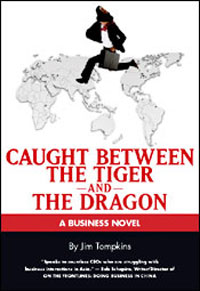A key early and challenging exercise Morrison puts the team through is identifying what really are Stabler’s “core capabilities,” and what are not, and within “core,” what are primary and secondary. All but the primary core functions are at least candidates for outsourcing, but when core is at one point defined as processes/functions that touch the customer, the executive team soon finds just about everything touches the customer in some way or another. So, they have to look at the question through a slightly different lens.
 Starting from scratch in moving to China isn’t easy for Stabler, especially when, for mysterious reasons, direct travel to China is largely banned by the private equity group to reduce costs. The firm views the travel as unnecessary because the CEO of another company it has all the contacts and expertise Stabler should need. Starting from scratch in moving to China isn’t easy for Stabler, especially when, for mysterious reasons, direct travel to China is largely banned by the private equity group to reduce costs. The firm views the travel as unnecessary because the CEO of another company it has all the contacts and expertise Stabler should need.
Unexpected challenges naturally develop – it turns out, for example, that certain production equipment that was custom made for Stabler, is not easily moved, and requires unique expertise to operate it effectively. Morrison battles with the private equity team over his plans to offer reasonably generous severance and training packages to workers to be laid off as a result of the offshoring, which the PE types consider as giving away “free money.”
Not surprisingly, things go awry – major quality and delivery problems soon arise, in large part because Stabler fails to get the relationship part of its China outsourcing strategy right. What is surprising is the fate of Rich Morrison and Stabler itself, but to learn that you will need to read the book.
Clearly, part of the message here is that the financially obsessed world that too many of us live under right now is not good for executives, workers, or companies themselves. The private equity honchos are portrayed almost as caricatures of bottom-line focused, but, ultimately, ineffective business leaders. But for many readers, those caricatures will ring too close to the reality.
The book is also, in the end, a very strong endorsement of a China strategy, though demonstrating that there are many obstacles to success. There are a few rays of hope for domestic US manufacturing, but primarily for just certain niches of a company’s products. The VP of manufacturing at Stabler, for example, moves from being strongly against an offshore strategy to become one of its most committed proponents.
In the end, the main message is about relationships – both with customers and with “partners” in China. Those companies that don’t really think that way are unlikely to succeed, Morrison comes to realize.
What perhaps the greatest value of the book is to remind us that no matter how we wish the world and business operated, you have to “get real” and learn to thrive based on that reality – even if part of you wished the world was different.
Does private equity, and Wall Street for that matter, so focus on the numbers that companies can’t manage for the long term? How does that manifest itself in the supply chain? Do you like the “business novel” approach? Let us know your thoughts at the Feedback button below.
SCDigest is Twittering!
Follow us now at https://twitter.com/scdigest |